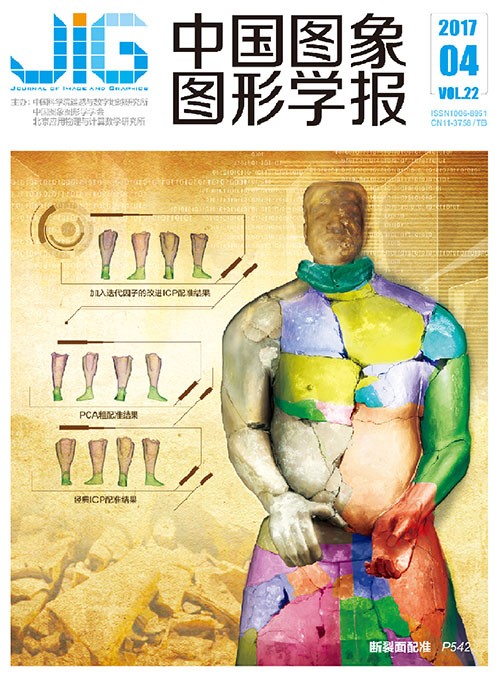
局部均值噪声估计的盲3维滤波降噪算法
摘 要
目的 图像在获取和传输的过程中很容易受到噪声的干扰,图像降噪作为众多图像处理系统的预处理模块在过去数十年中得到了广泛的研究。在已提出的降噪算法中,往往采用加性高斯白噪声模型AWGN(additive white Gaussian noise)为噪声建模,噪声水平(严重程度)由方差参数控制。经典的BM3D 3维滤波算法属于非盲降噪(non-blind denoising algorithm)算法,在实际使用中需要由人工评估图像噪声水平并设置参数,存在着噪声评估值随机性大而导致无法获得最佳降噪效果的问题。为此,提出了一种新的局部均值噪声估计(LME)算法并作为BM3D算法的前置预处理模块。方法 本文专注于利用基于自然统计规律(NSS)的图像质量感知特征和局部均值估计技术构建图像噪声水平预测器,并通过它高效地获得噪声图像中准确的噪声水平值。关于自然场景统计方面的研究表明,无失真的自然场景图像在空域或者频率域上具有显著的统计规律,一旦受到噪声干扰会产生规律性的偏移,可以提取这些特征值作为反映图像质量好坏的图像质量感知特征。另外,局部均值估计因其简单而高效率的预测特性被采用。具体实现上,在具有广泛代表性且未受噪声干扰图像集合上添加不同噪声水平的高斯噪声构建失真图像集合,然后利用小波变换对这些失真图像进行不同尺度和不同方向的分解,再用广义高斯分布模型(GGD)提取子带滤波系数的统计信息构成描述图像失真程度的特征矢量,最后用每幅失真图像上所提取的特征矢量及对其所施加的高斯噪声水平值构成了失真特征矢量库。在降噪阶段,用相同的特征提取方法提取待降噪的图像的特征矢量并在失真特征矢量库中检索出与之类似的若干特征矢量及它们所对应的噪声水平值,然后用局部均值法估计出待降噪图像中高斯噪声大小作为经典BM3D算法的输入参数。结果 改进后的BM3D算法转换为盲降噪算法,称为BM3D-LME(block-matching and 3D filtering based on local means estimation)算法。准确的噪声估计对于诸如图像降噪,图像超分辨率和图像分割等图像处理任务非常重要。已经验证了所提出噪声水平估计算法的准确性、鲁棒性和有效性。结论 相对人工进行噪声估计,LME算法能够准确、快速地估算出任意待降噪图像中的噪声大小。配合BM3D算法使用后,有效提高了它的实际降噪效果并扩大它的应用范围。
关键词
Noise level estimation based on local means and its application to the blind BM3D denoising algorithm
Xu Shaoping, Zhang Xingqiang, Jiang Yinnan, Tang Yiling, Jiang Shunliang(School of Information Engineering, Nanchang University, Nanchang 330031, China) Abstract
Objective Observed images can be easily contaminated by various noises during acquisition or transmission. As an important preprocessing module for various image processing systems, image denoising has been explored extensively in the last few decades. Various image denoising algorithms have been developed to improve the quality of images corrupted by some form of noise model, which is frequently assumed to be additive white Gaussian noise in the literature. As the core parameter of the non-blind block-matching and 3D filtering (BM3D) algorithm, noise level (i.e., variance) should be set manually in actual applications. This procedure significantly affects the noise reduction performance of the BM3D algorithm and limits its application scope due to inaccurate noise level estimation. To resolve this problem, a novel local means estimation (LME) algorithm that is utilized as the preprocessing module of the BM3D algorithm is proposed. Method In this work, we focus on solving the problem based on the quality-aware feature extraction of natural scene statistics (NSS) and local means techniques, which we can apply to automatically predict the noise level parameter with high accuracy and efficiency. Research on NSS has clearly demonstrated that clean images of natural scenes belong to a small set of space of all possible images and exhibit strong predictable statistical regularities in the spatial or frequency domain that can distinguish them from corrupted ones. By contrast, nonlocal means-based estimation exhibits the right features that interest us, such as its conceptual simplicity and effectiveness. In particular, several widely representative and clean images were selected and corrupted by Gaussian noise with different variances to constitute a set of distorted images. The sub-band coefficients of a corrupted image obtained from wavelet transform over three scales and three orientations were parameterized using generalized Gaussian distribution. These estimated parameters were used to form a feature vector that described image noise level. The feature vector extracted from each distorted image belonging to the distorted image set and the corresponding Gaussian noise variance constituted the feature vector database. The proposed quality-aware features have extremely low computational complexity, thereby making them appropriate for time-constrained applications. During the noise reduction stage, the feature vector of a noisy image to be denoised was extracted using the same feature extraction approach. We selected the feature vectors and the corresponding noise level values that were similar to the extracted feature of the noisy image in the feature vector database to estimate its variance using the LME approach. The estimated variance was subsequently used as the input parameter of the BM3D algorithm. Result The BM3D algorithm was transformed into a blind denoising algorithm called BM3D based on the LME algorithm (BM3D-LME). The accurate estimation of noise level from a single noisy image is of fundamental interest in a wide variety of digital image processing applications. This procedure is highly important for tasks such as denoising, super-resolution, and segmentation. We verified the accuracy, robustness, and effectiveness of the proposed method on a large number of representative images from several benchmark databases. Conclusion Experimental results show that the LME algorithm can accurately and rapidly estimate the noise level in any image to be denoised. The actual noise reduction effect of the BM3D algorithm is effectively improved with the aid of LME, and its application scope is also expanded.
Keywords
noise level estimation feature vector extraction local means estimation block-matching and 3D filtering (BM3D) blind image denoising
|



 中国图象图形学报 │ 京ICP备05080539号-4 │ 本系统由
中国图象图形学报 │ 京ICP备05080539号-4 │ 本系统由